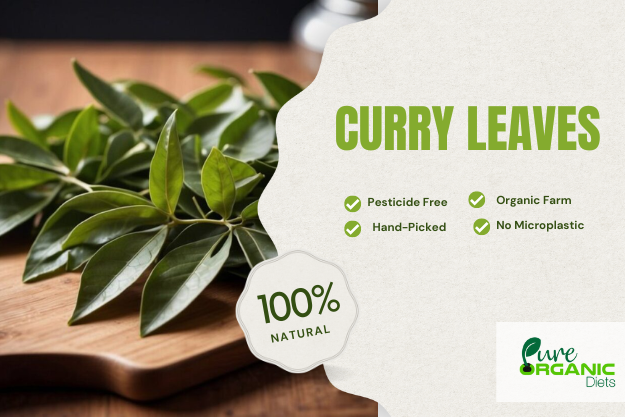How Curry Leaves Spice Elevates Culinary Creations

Introduction -
Curry leaves, known for their aromatic fragrance and distinct flavor, are a staple ingredient in South Asian cuisine. Beyond their culinary uses, curry leaves offer a multitude of health benefits and can elevate the taste and aroma of various dishes. In this comprehensive guide, we’ll explore the versatility of curry leaves spice and how it enhances culinary creations.
Origin and History of Curry Leaves:
Curry leaves, scientifically known as Murraya koenigii, are native to South Asia and have been used in Indian cooking for centuries. They are derived from the curry tree, a tropical plant with glossy green leaves and small, fragrant flowers. In Indian culture, curry leaves are considered sacred and are often used in religious rituals and ceremonies. Over time, curry leaves have gained popularity in cuisines around the world for their unique flavor and aroma.
Flavor Profile of Curry Leaves:
Curry leaves have a complex flavor profile that is both aromatic and slightly bitter. They are known for their intense, citrusy aroma with hints of spice and earthiness. When used in cooking, curry leaves impart a subtle yet distinctive flavor that enhances the overall taste of dishes. The flavor of curry leaves is best described as fresh, herbal, and slightly nutty, making them a versatile ingredient in a wide range of culinary creations.
Culinary Uses of Curry Leaves Spice:
Curry leaves spice is a versatile ingredient that can be used in various ways to enhance the flavor and aroma of dishes. Here are some popular culinary uses of curry leaves spice:
Tempering:
Curry leaves are commonly used in tempering, a cooking technique used in Indian cuisine to enhance the flavor of spices and aromatics. To temper spices, curry leaves are fried in hot oil or ghee along with other spices like mustard seeds, cumin seeds, and dried red chilies. The tempered spices are then added to dishes like dal, rice, and curries to infuse them with flavor.
Seasoning:
Curry leaves spice can be used as a seasoning for a wide range of dishes, including soups, stews, salads, and marinades. Simply crush or tear fresh curry leaves and sprinkle them over dishes as a garnish to add a burst of flavor and aroma. Curry leaves can also be dried and powdered to make a versatile seasoning blend that can be used in various recipes.
Flavoring:
Curry leaves spice can be used to flavor a variety of dishes, including meat, poultry, seafood, and vegetables. Simply add fresh or dried curry leaves to marinades, sauces, and dressings to infuse them with a rich, aromatic flavor. Curry leaves can also be used to flavor rice dishes, pilafs, and biryanis for an added layer of complexity.
Infusing:
Curry leaves can be used to infuse flavor into oils, vinegars, and syrups, creating versatile flavoring agents that can be used in cooking and baking. Simply heat oil or vinegar and add fresh curry leaves, allowing them to steep for several minutes to release their flavor and aroma. The infused oil or vinegar can be used to dress salads, drizzle over grilled meats, or add flavor to marinades and sauces.
Health Benefits of Curry Leaves:
In addition to their culinary uses, curry leaves offer a range of health benefits due to their nutrient-rich profile. Here are some potential health benefits of curry leaves:
Rich in Antioxidants:
Curry leaves are rich in antioxidants, including flavonoids, phenolic compounds, and vitamins A and C, which help protect cells from oxidative damage caused by free radicals. Regular consumption of curry leaves may help reduce inflammation, prevent chronic diseases, and promote overall health and well-being.
Supports Digestive Health:
Curry leaves contain compounds that help stimulate the secretion of digestive enzymes and promote healthy gut motility, aiding in digestion and alleviating digestive issues such as bloating, gas, and indigestion.
Blood Sugar Regulation:
Some studies suggest that curry leaves may help regulate blood sugar levels and improve insulin sensitivity, making them beneficial for individuals with diabetes. Compounds found in curry leaves may help reduce insulin resistance and promote glucose metabolism.
Hair and Skin Health:
Curry leaves are often used in traditional medicine for their purported benefits for hair and skin health. They are believed to help strengthen hair follicles, reduce hair loss, and promote hair growth. Additionally, curry leaves may have antibacterial and antifungal properties that help prevent acne and other skin infections.
Conclusion
Curry leaves spice is a versatile ingredient that adds depth, complexity, and aroma to culinary creations. Whether used in tempering, seasoning, flavoring, or infusing, curry leaves enhance the taste and aroma of dishes with their unique flavor profile. Beyond their culinary uses, curry leaves offer a range of health benefits due to their nutrient-rich profile, making them a valuable addition to any diet. By incorporating curry leaves spice into your cooking repertoire, you can elevate the flavor of your dishes and enjoy the numerous health benefits that curry leaves have to offer.
